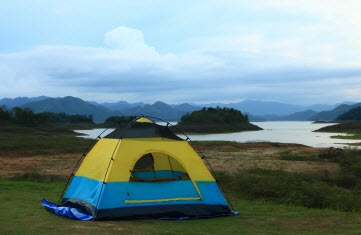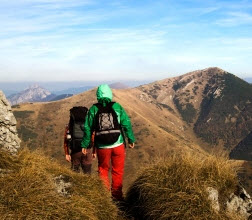 Romona Weston Romona Weston
We are a family of campers an hikers! Experiencing the true outdoors with your family can be one of the most rewarding experiences you can undertake.
As with many ventures, a safe and successful camping trip requires effective planning. To ensure your planned mountain hike doesnít end up being memorable for the wrong reasons, pay attention to the six safety tips below.
1. Know your limits Ė and the risks.
You may have romantic notions of a Cody Lundin-style primitive survival adventure ( best-selling author on survival and preparedness) but if you donít have the experience or training, it is advisable to start small. A family of novice campers should wet their feet with a day trip while more experienced families might opt for a few days or a week in the great outdoors.
.jpg) Photo Courtesy Think4PhotoOp Photo Courtesy Think4PhotoOp
Children are particularly vulnerable to danger. Younger children have underdeveloped sweat glands so their temperature regulation is poor. Keep them out of the sun during the hottest part of the day.
It is vitally important that children do not get separated from you; try to educate them in the importance of remembering landmarks as they walk, and teach them to use the universal distress call, three loud noises or blows of a whistle, should they get lost. Older children could attend a map-reading course prior to travel.
All hikers are vulnerable to exposure to the elements, whether heat, cold, rain or wind, if sufficient shelter isnít available or if inappropriate clothing is worn.
2. Pack the right clothing and equipment.
Inexperienced hikers may not appreciate the way in which weather conditions can rapidly deteriorate, especially at high altitude. Storms can strike at any time of the year, and temperatures can plummet without warning in the spring and fall, especially at night.
 Photo Courtesy Wiangya Photo Courtesy Wiangya
Dressing in layers is the solution for hiking, so make sure you pack plenty of clothes. Long-sleeved sweaters and shirts and tank tops, made of polyester, polypropylene or wool are recommended, and lightweight waterproof pants and coats are essential. Pack caps or hats for the whole family, especially the children, and ensure you are all fitted out in quality hiking shoes; there are few things more unbearable than attempting a grueling hike with blistered feet.
Equipment generally considered as essential are a tent; ground insulation, sleeping bags, a topographical map, compass, flashlight with extra batteries and bulbs, plenty of water, sunglasses and sun cream, insect repellent, a first aid kit, pocketknife, candles or a fire starter, matches (either waterproof or in a waterproof container), a small saw, blankets, duct tape, nylon rope and various emergency means of signaling (e.g., cell phone, whistles, flares, etc.)
3. Choose your campground carefully.
There are a few things to think about before setting up camp. Is the area prone to flooding? If so, ensure you pick an elevated spot.
Are there any wild berries? Donít place your tent too close to them or foraging bears might pay you an unwelcome visit.
 Photo Courtesy Michal Morcol Photo Courtesy Michal Morcol
Are there any signs of fire-pits you can use? If it is dry season, forego the fire-pit altogether as the risk of sparking a fire is too great.
Try not to pick a spot too close to trees, in case one should fall overnight.
Keep food packed away in the car overnight, in animal-resistant boxes, to avoid attracting animals.
4. Donít drink the water.
As long as you pack plenty of drinking water, you shouldnít have to drink from natural water sources. It is safest to assume that any water you come across is likely to have been contaminated by animals. The water-living parasite, Giardia lamblia, is a common menace to unwary hikers, causing unpleasant digestive complaints.
If you do have to drink river or stream water, be sure to boil it first, if at all possible. Water can also be purified by iodine tablets, so add some to your travel kit.
5. Bring extra food.
It may seem obvious, but pack more food than you think you will need, in case of emergencies. Portable foods such as trail mix and fruit are recommended, as is dehydrated food if you can get hold of it; it saves valuable kit space and you need only add water.
Foraging for your own food is unwise unless you are an expert in identifying what is safe to eat. Inexperienced campers run the risk of misidentifying berries and mushrooms, leading to illness or worse.
6. Protect your family from animals, insects and poisonous plants.
Children should be warned that wild animals are not to be approached, no matter how cute and cuddly they appear. If biting insects are around, pants should be tucked into socks and insect repellent applied.
Citronella-based repellent can be applied to clothing or DEET-containing repellents can be used, although the latter is toxic to the skin and must not be used on children under two years of age. Check each other daily for tics, some of which carry Lyme disease.
Finally, try not to touch any unfamiliar plants; the oils can cause allergic reactions. Calamine lotion, or 1percent hydrocortisone cream, can be applied to ease the itching caused by some plant oils, including the poison ivy.
Following these tips will guarantee you and your family are well on the way to a safe and, hopefully, a wonderful camping experience. Have fun!
About The Author
Romona Weston lives in southeastern Pennsylvania in the beautiful Amish countryside of Lancaster County. She and her husband have seven children. In her spare time, she loves to hike, write and organize and has home-schooled for over 20 years.
Weston is a Web publisher who writes about various subjects, (like every sort of stainless steel top kitchen carts and portable kitchen carts.) As a researcher rather than a seller, she presents an unbiased view of products. Explore her reviews at www.kitchencarts360.com
www.azbw.com
jim@azbw.com
Recreation Is Mobile.®
DD ® reaches 40,000 readers weekly. Get Your Free Copy Subscribe Dinghy Digest
Copyright ©2009 Western Outdoor Times/Arizona Boating & Watersports. All Rights Reserved
|
